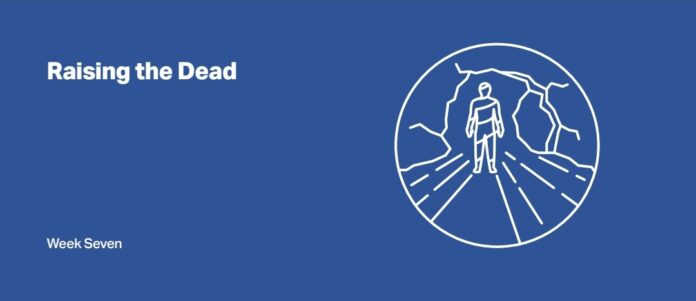The Gospel of John | Week 07- RAISING THE DEAD
Week’s Passage: John 11
InTro
Returning to the crucible
In John 10 and 11, Jesus withdraws from Jerusalem to minister in a remote area beyond the Jordan but is soon called back by the urgent news of His friend Lazarus’ illness. Despite the plea, Jesus delays, knowing Lazarus’ death will reveal God’s glory. When Jesus arrives, He raises Lazarus from the dead, a miracle that confirms His divine authority over life and death. This event divides the people: some believe in Jesus, while others, particularly the religious leaders, are provoked to plot His death. The story, filled with layered imagery, symbolizes not only physical resurrection but also the eternal life Jesus offers, foreshadowing His own victory over death.
inGest
Coming to Bethany
Lazarus, Mary, and Martha were beloved friends of Jesus. When Lazarus fell ill, Jesus delayed His visit, planning to reveal God’s glory through Lazarus’ resurrection. His delay puzzled the disciples, who feared the danger in Judea, yet Jesus reminded them His timing follows God’s will. Thomas bravely offered to follow Jesus, but despite their loyalty, the disciples would later abandon Him at His arrest.
inTerpret
Lazurus Resurrected
In John 11, Jesus arrives in Bethany to find Lazarus dead for four days, making his resurrection seem impossible by Jewish beliefs. Martha, though grieving, expresses faith in Jesus, and He assures her that Lazarus will rise, declaring Himself the Resurrection and the Life. Deeply moved, Jesus calls Lazarus from the grave, demonstrating His power over death and establishing His identity as the Messiah. This miracle, witnessed by many, solidified belief in Jesus as the source of eternal life.
inVite
Reactions to the Live Giver
Invite
In John 11, Jesus’ raising of Lazarus reveals Him as the Life-Giver and divides responses. Some witnesses believe in Him, while others report to the Pharisees, leading to a council determined to stop Jesus. Caiaphas, the high priest, suggests that Jesus’ death would benefit the nation, unknowingly hinting at Jesus’ sacrificial role. This miracle becomes the turning point, as leaders plot His death. The chapter emphasizes a key theme: Jesus’ light calls for a response—either faith or resistance. Each person must choose their path.
inSight
Disappointment and Sorrow
Ellen G. White reflects on Jesus’ delayed response to Lazarus’ illness, which surprised the disciples but ultimately demonstrated His compassion. Jesus’ statement, “Our friend Lazarus sleepeth,” reassured them of His care. He wept, not for Lazarus but for the unbelief in those who would soon plot His death despite His miracles. Caiaphas, the high priest, unknowingly prophesied Jesus’ sacrificial role but twisted it, suggesting that Jesus’ death would allow the nation to continue in sin rather than lead to repentance.
inQuire
- What was Christ’s purpose in allowing delay and disappointment? (John 11:6, 32.)
- Considering the timing of Jesus’ travels (John 11:3–14, 54), what principles should guide our life decisions?
- Consider John 11:47, 48. In what ways does your pride prevent you from taking a stand for Jesus?
- Take a moment to enter a prayerful state of mind. Meditate on John 11:33–44. If you were in the crowd, what would some of your reactions be? Share your insights.



